Transfer Pricing and Approaches for Determining Transfer Price
VerifiedAdded on 2023/03/20
|17
|4029
|35
AI Summary
This report discusses the concept of transfer pricing and various approaches that can be used to determine the transfer price. It also provides recommendations for optimizing performance and efficiency through the implementation of a performance measurement approach.
Contribute Materials
Your contribution can guide someone’s learning journey. Share your
documents today.
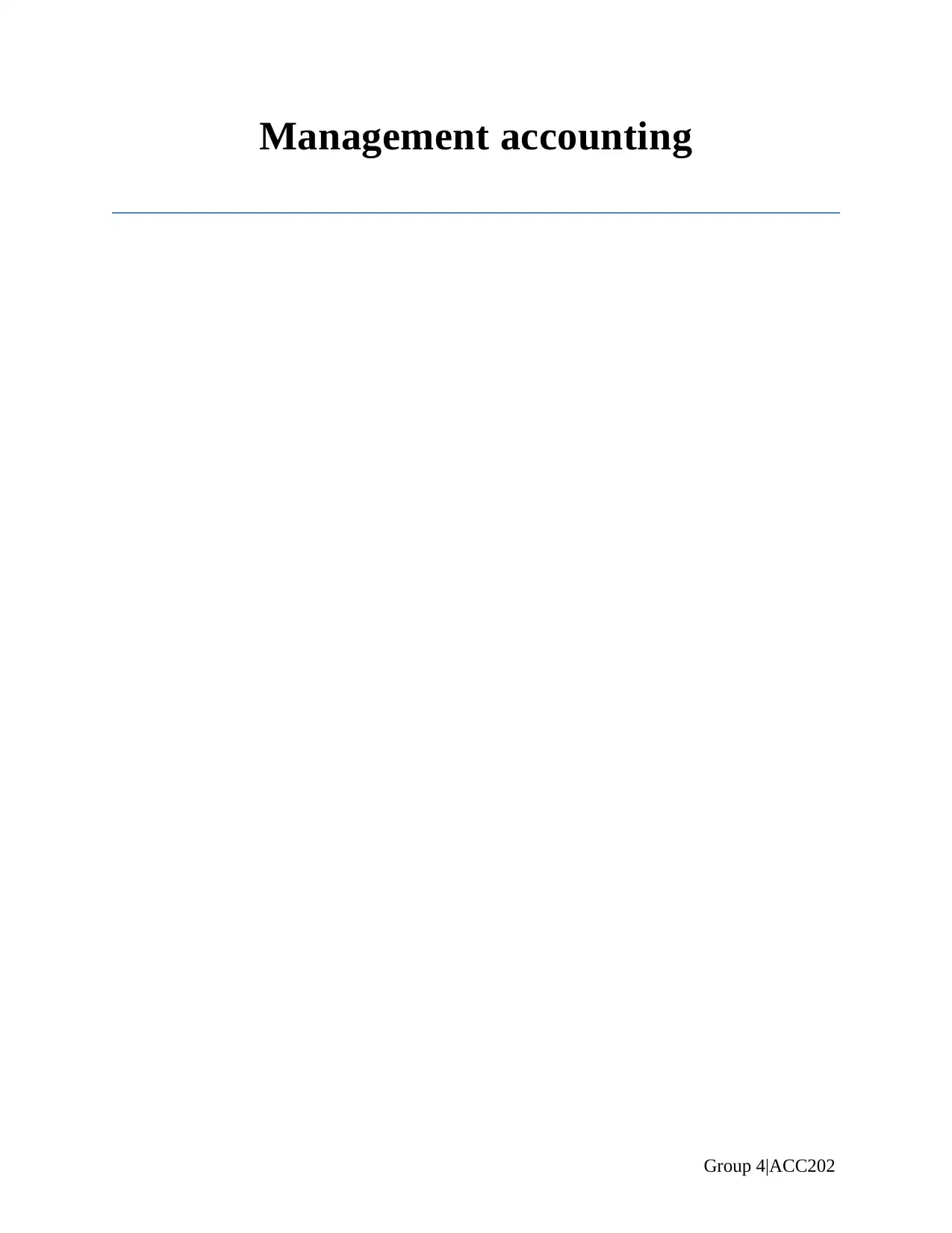
Management accounting
Group 4|ACC202
Group 4|ACC202
Secure Best Marks with AI Grader
Need help grading? Try our AI Grader for instant feedback on your assignments.
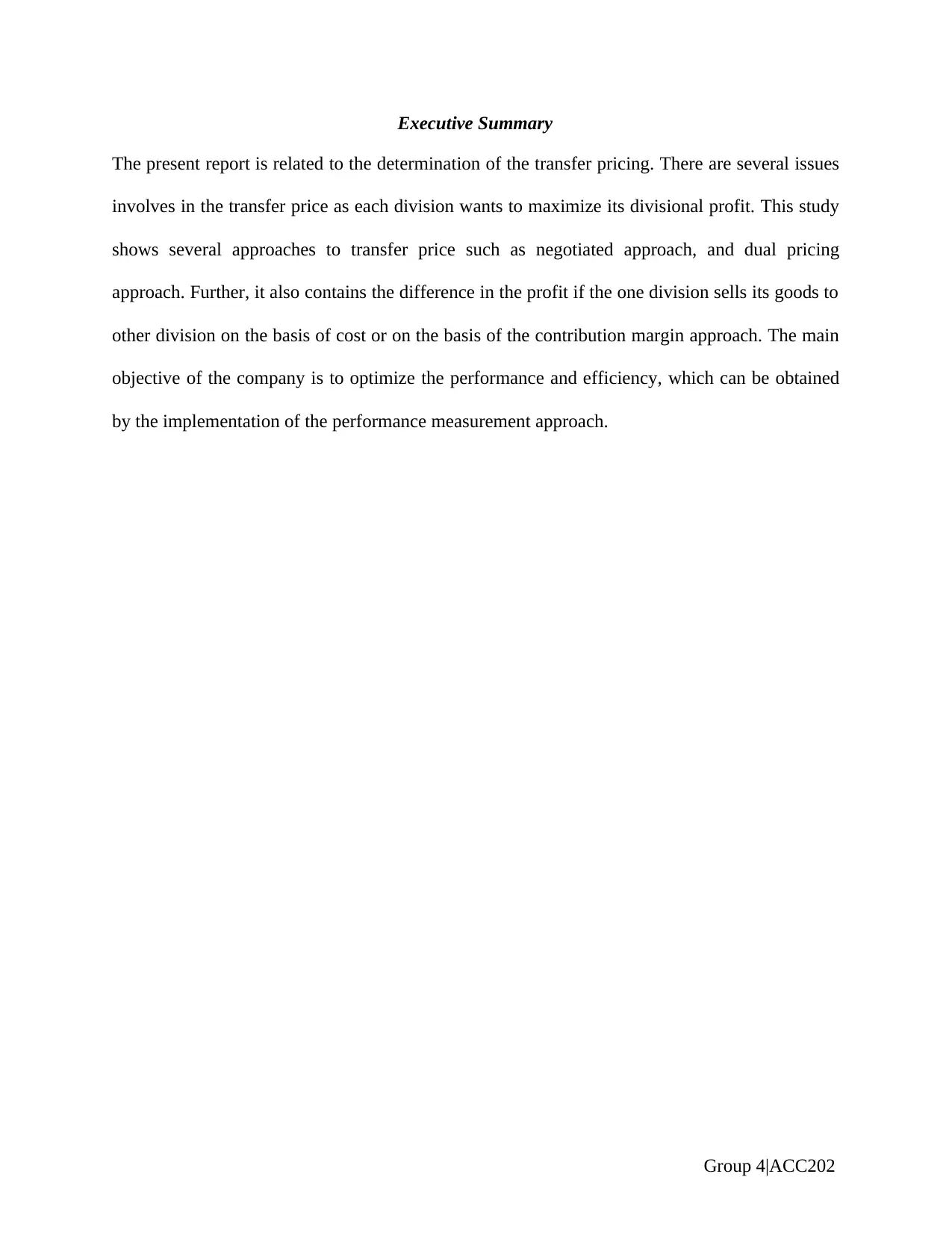
Executive Summary
The present report is related to the determination of the transfer pricing. There are several issues
involves in the transfer price as each division wants to maximize its divisional profit. This study
shows several approaches to transfer price such as negotiated approach, and dual pricing
approach. Further, it also contains the difference in the profit if the one division sells its goods to
other division on the basis of cost or on the basis of the contribution margin approach. The main
objective of the company is to optimize the performance and efficiency, which can be obtained
by the implementation of the performance measurement approach.
Group 4|ACC202
The present report is related to the determination of the transfer pricing. There are several issues
involves in the transfer price as each division wants to maximize its divisional profit. This study
shows several approaches to transfer price such as negotiated approach, and dual pricing
approach. Further, it also contains the difference in the profit if the one division sells its goods to
other division on the basis of cost or on the basis of the contribution margin approach. The main
objective of the company is to optimize the performance and efficiency, which can be obtained
by the implementation of the performance measurement approach.
Group 4|ACC202
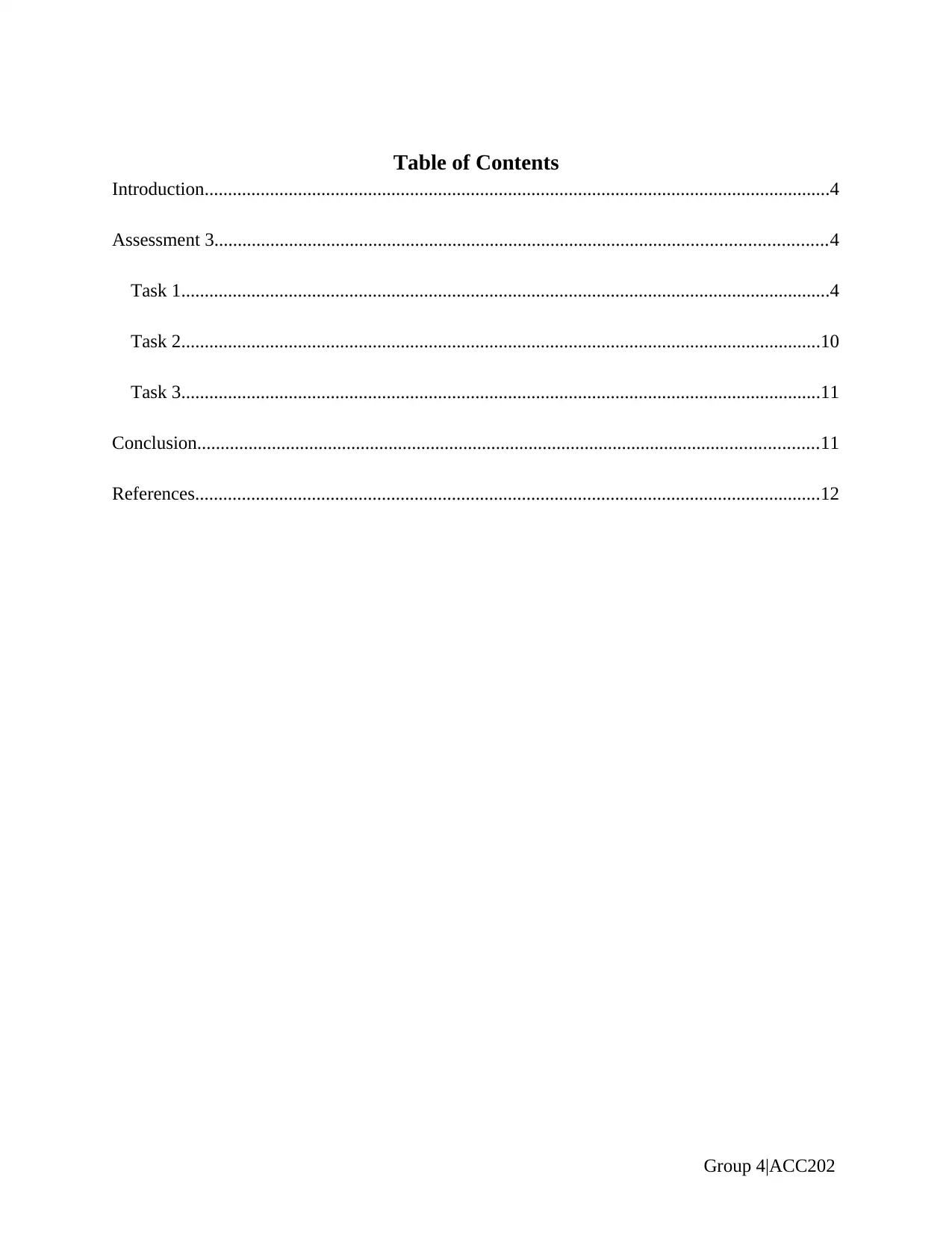
Table of Contents
Introduction......................................................................................................................................4
Assessment 3...................................................................................................................................4
Task 1...........................................................................................................................................4
Task 2.........................................................................................................................................10
Task 3.........................................................................................................................................11
Conclusion.....................................................................................................................................11
References......................................................................................................................................12
Group 4|ACC202
Introduction......................................................................................................................................4
Assessment 3...................................................................................................................................4
Task 1...........................................................................................................................................4
Task 2.........................................................................................................................................10
Task 3.........................................................................................................................................11
Conclusion.....................................................................................................................................11
References......................................................................................................................................12
Group 4|ACC202
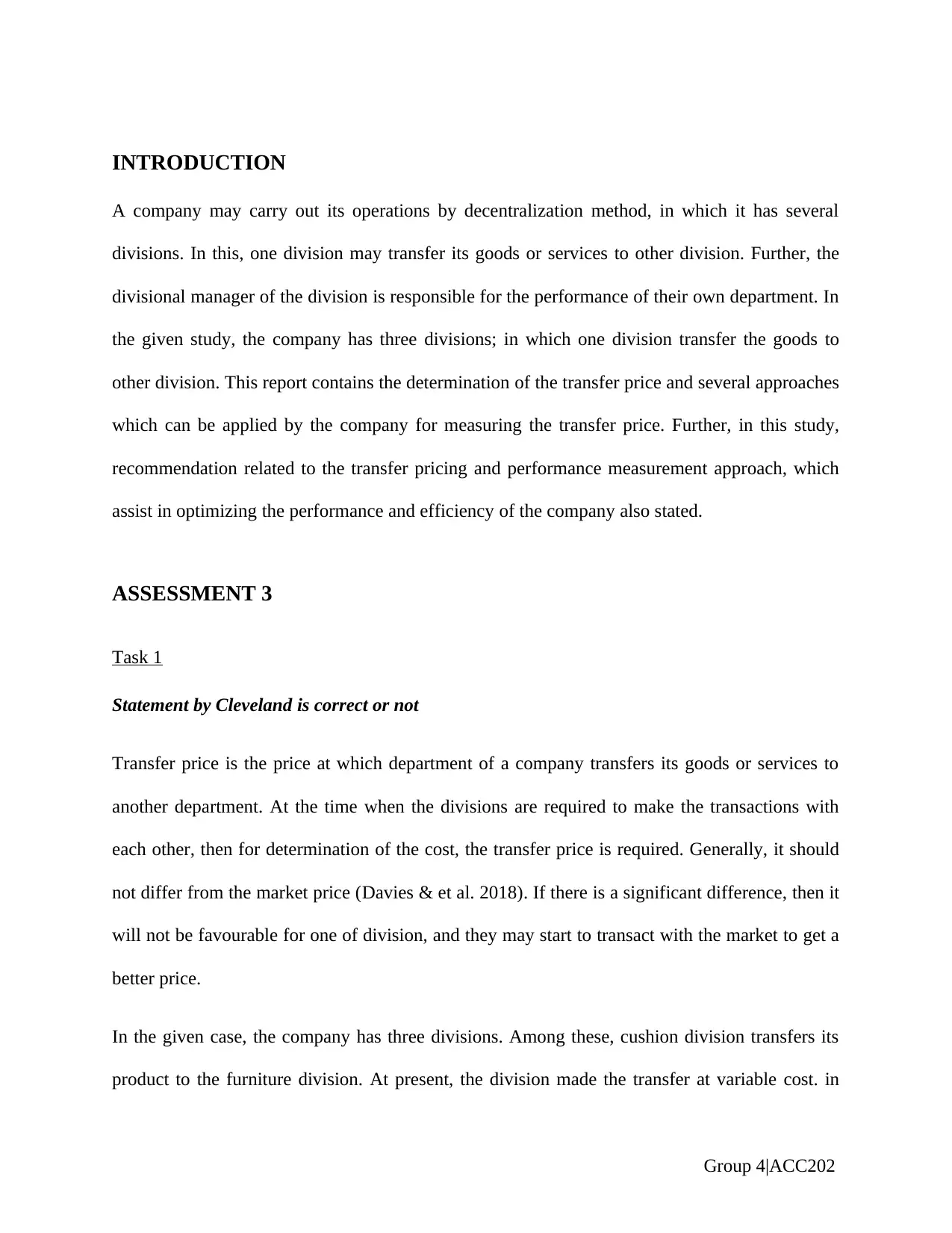
INTRODUCTION
A company may carry out its operations by decentralization method, in which it has several
divisions. In this, one division may transfer its goods or services to other division. Further, the
divisional manager of the division is responsible for the performance of their own department. In
the given study, the company has three divisions; in which one division transfer the goods to
other division. This report contains the determination of the transfer price and several approaches
which can be applied by the company for measuring the transfer price. Further, in this study,
recommendation related to the transfer pricing and performance measurement approach, which
assist in optimizing the performance and efficiency of the company also stated.
ASSESSMENT 3
Task 1
Statement by Cleveland is correct or not
Transfer price is the price at which department of a company transfers its goods or services to
another department. At the time when the divisions are required to make the transactions with
each other, then for determination of the cost, the transfer price is required. Generally, it should
not differ from the market price (Davies & et al. 2018). If there is a significant difference, then it
will not be favourable for one of division, and they may start to transact with the market to get a
better price.
In the given case, the company has three divisions. Among these, cushion division transfers its
product to the furniture division. At present, the division made the transfer at variable cost. in
Group 4|ACC202
A company may carry out its operations by decentralization method, in which it has several
divisions. In this, one division may transfer its goods or services to other division. Further, the
divisional manager of the division is responsible for the performance of their own department. In
the given study, the company has three divisions; in which one division transfer the goods to
other division. This report contains the determination of the transfer price and several approaches
which can be applied by the company for measuring the transfer price. Further, in this study,
recommendation related to the transfer pricing and performance measurement approach, which
assist in optimizing the performance and efficiency of the company also stated.
ASSESSMENT 3
Task 1
Statement by Cleveland is correct or not
Transfer price is the price at which department of a company transfers its goods or services to
another department. At the time when the divisions are required to make the transactions with
each other, then for determination of the cost, the transfer price is required. Generally, it should
not differ from the market price (Davies & et al. 2018). If there is a significant difference, then it
will not be favourable for one of division, and they may start to transact with the market to get a
better price.
In the given case, the company has three divisions. Among these, cushion division transfers its
product to the furniture division. At present, the division made the transfer at variable cost. in
Group 4|ACC202
Secure Best Marks with AI Grader
Need help grading? Try our AI Grader for instant feedback on your assignments.
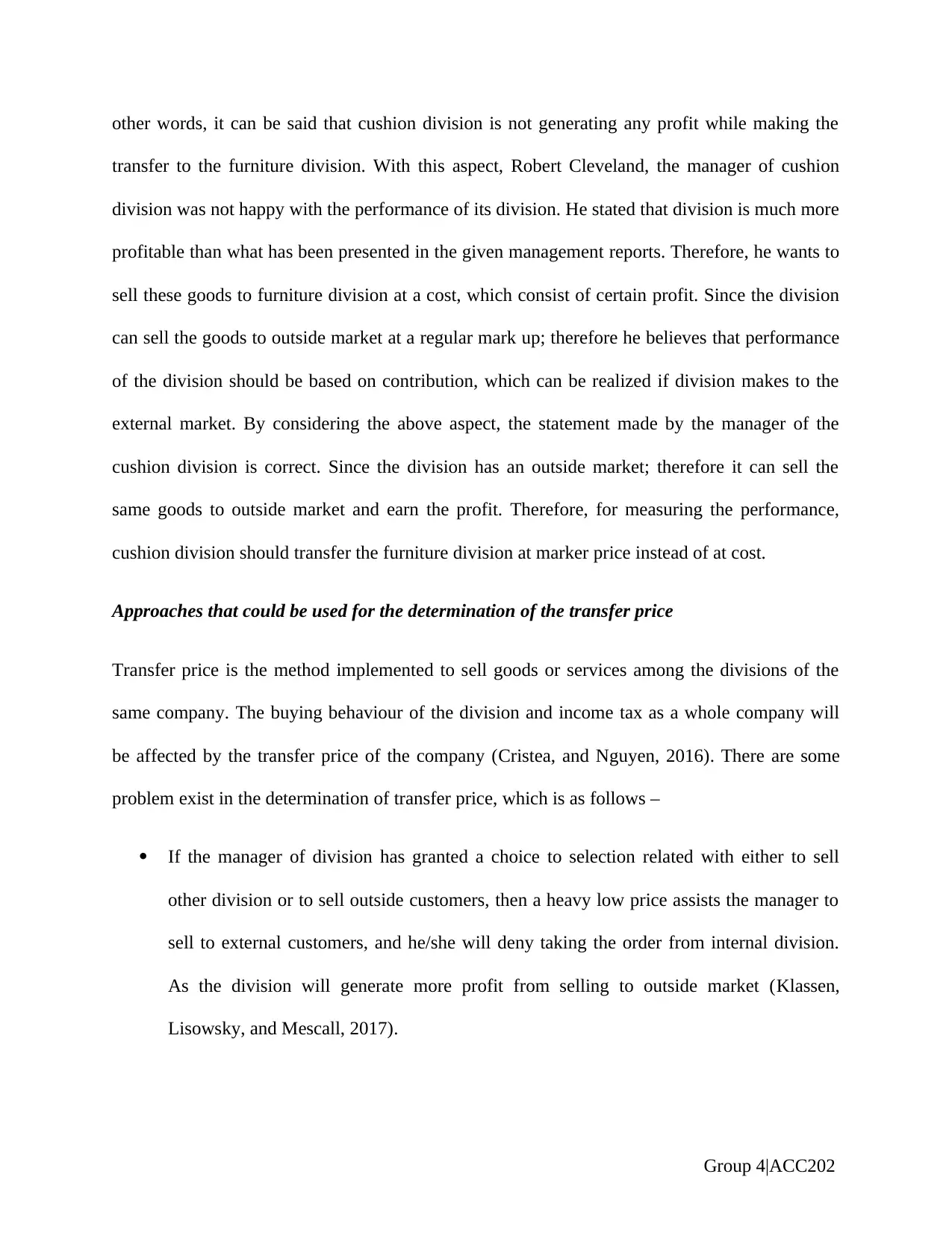
other words, it can be said that cushion division is not generating any profit while making the
transfer to the furniture division. With this aspect, Robert Cleveland, the manager of cushion
division was not happy with the performance of its division. He stated that division is much more
profitable than what has been presented in the given management reports. Therefore, he wants to
sell these goods to furniture division at a cost, which consist of certain profit. Since the division
can sell the goods to outside market at a regular mark up; therefore he believes that performance
of the division should be based on contribution, which can be realized if division makes to the
external market. By considering the above aspect, the statement made by the manager of the
cushion division is correct. Since the division has an outside market; therefore it can sell the
same goods to outside market and earn the profit. Therefore, for measuring the performance,
cushion division should transfer the furniture division at marker price instead of at cost.
Approaches that could be used for the determination of the transfer price
Transfer price is the method implemented to sell goods or services among the divisions of the
same company. The buying behaviour of the division and income tax as a whole company will
be affected by the transfer price of the company (Cristea, and Nguyen, 2016). There are some
problem exist in the determination of transfer price, which is as follows –
If the manager of division has granted a choice to selection related with either to sell
other division or to sell outside customers, then a heavy low price assists the manager to
sell to external customers, and he/she will deny taking the order from internal division.
As the division will generate more profit from selling to outside market (Klassen,
Lisowsky, and Mescall, 2017).
Group 4|ACC202
transfer to the furniture division. With this aspect, Robert Cleveland, the manager of cushion
division was not happy with the performance of its division. He stated that division is much more
profitable than what has been presented in the given management reports. Therefore, he wants to
sell these goods to furniture division at a cost, which consist of certain profit. Since the division
can sell the goods to outside market at a regular mark up; therefore he believes that performance
of the division should be based on contribution, which can be realized if division makes to the
external market. By considering the above aspect, the statement made by the manager of the
cushion division is correct. Since the division has an outside market; therefore it can sell the
same goods to outside market and earn the profit. Therefore, for measuring the performance,
cushion division should transfer the furniture division at marker price instead of at cost.
Approaches that could be used for the determination of the transfer price
Transfer price is the method implemented to sell goods or services among the divisions of the
same company. The buying behaviour of the division and income tax as a whole company will
be affected by the transfer price of the company (Cristea, and Nguyen, 2016). There are some
problem exist in the determination of transfer price, which is as follows –
If the manager of division has granted a choice to selection related with either to sell
other division or to sell outside customers, then a heavy low price assists the manager to
sell to external customers, and he/she will deny taking the order from internal division.
As the division will generate more profit from selling to outside market (Klassen,
Lisowsky, and Mescall, 2017).
Group 4|ACC202
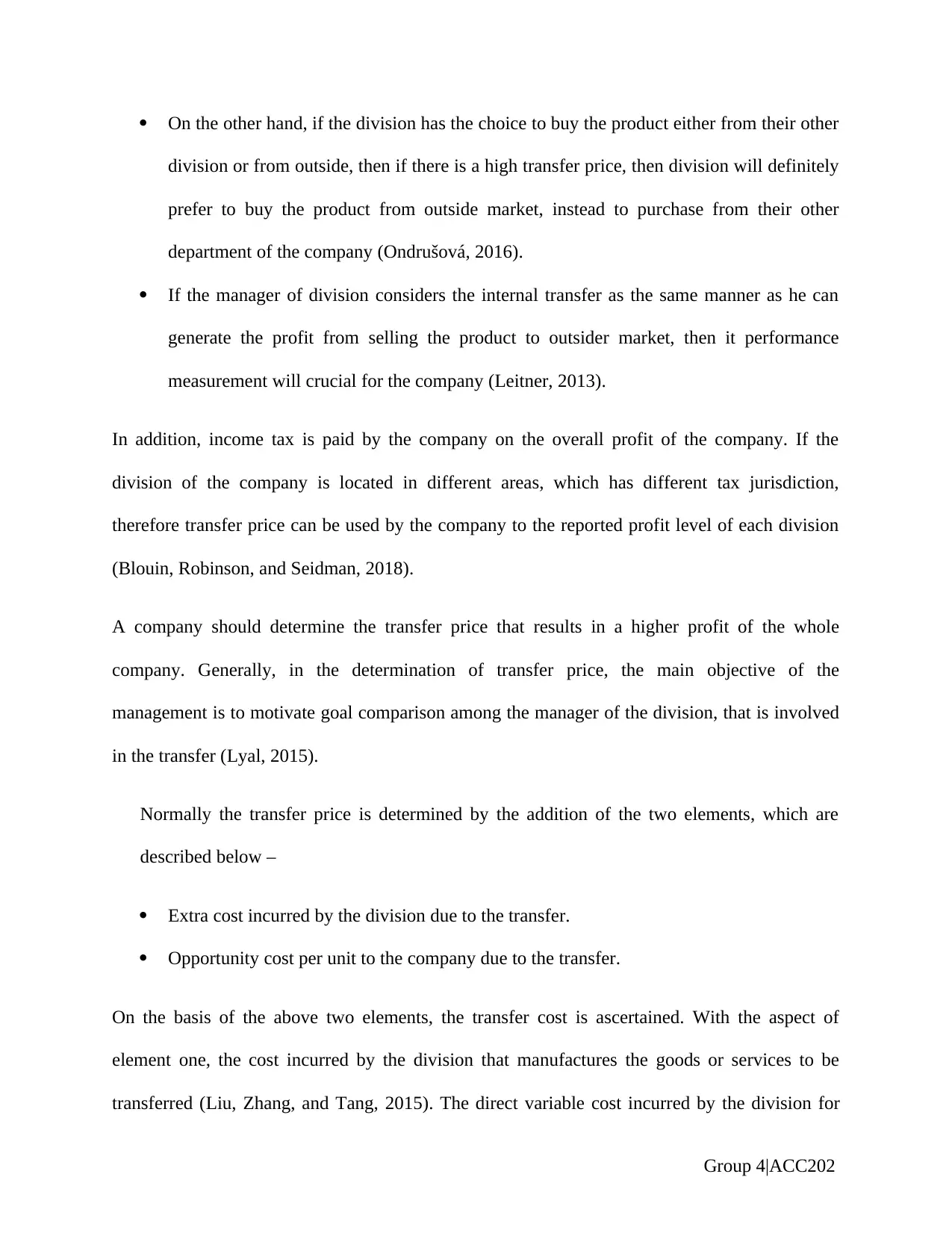
On the other hand, if the division has the choice to buy the product either from their other
division or from outside, then if there is a high transfer price, then division will definitely
prefer to buy the product from outside market, instead to purchase from their other
department of the company (Ondrušová, 2016).
If the manager of division considers the internal transfer as the same manner as he can
generate the profit from selling the product to outsider market, then it performance
measurement will crucial for the company (Leitner, 2013).
In addition, income tax is paid by the company on the overall profit of the company. If the
division of the company is located in different areas, which has different tax jurisdiction,
therefore transfer price can be used by the company to the reported profit level of each division
(Blouin, Robinson, and Seidman, 2018).
A company should determine the transfer price that results in a higher profit of the whole
company. Generally, in the determination of transfer price, the main objective of the
management is to motivate goal comparison among the manager of the division, that is involved
in the transfer (Lyal, 2015).
Normally the transfer price is determined by the addition of the two elements, which are
described below –
Extra cost incurred by the division due to the transfer.
Opportunity cost per unit to the company due to the transfer.
On the basis of the above two elements, the transfer cost is ascertained. With the aspect of
element one, the cost incurred by the division that manufactures the goods or services to be
transferred (Liu, Zhang, and Tang, 2015). The direct variable cost incurred by the division for
Group 4|ACC202
division or from outside, then if there is a high transfer price, then division will definitely
prefer to buy the product from outside market, instead to purchase from their other
department of the company (Ondrušová, 2016).
If the manager of division considers the internal transfer as the same manner as he can
generate the profit from selling the product to outsider market, then it performance
measurement will crucial for the company (Leitner, 2013).
In addition, income tax is paid by the company on the overall profit of the company. If the
division of the company is located in different areas, which has different tax jurisdiction,
therefore transfer price can be used by the company to the reported profit level of each division
(Blouin, Robinson, and Seidman, 2018).
A company should determine the transfer price that results in a higher profit of the whole
company. Generally, in the determination of transfer price, the main objective of the
management is to motivate goal comparison among the manager of the division, that is involved
in the transfer (Lyal, 2015).
Normally the transfer price is determined by the addition of the two elements, which are
described below –
Extra cost incurred by the division due to the transfer.
Opportunity cost per unit to the company due to the transfer.
On the basis of the above two elements, the transfer cost is ascertained. With the aspect of
element one, the cost incurred by the division that manufactures the goods or services to be
transferred (Liu, Zhang, and Tang, 2015). The direct variable cost incurred by the division for
Group 4|ACC202
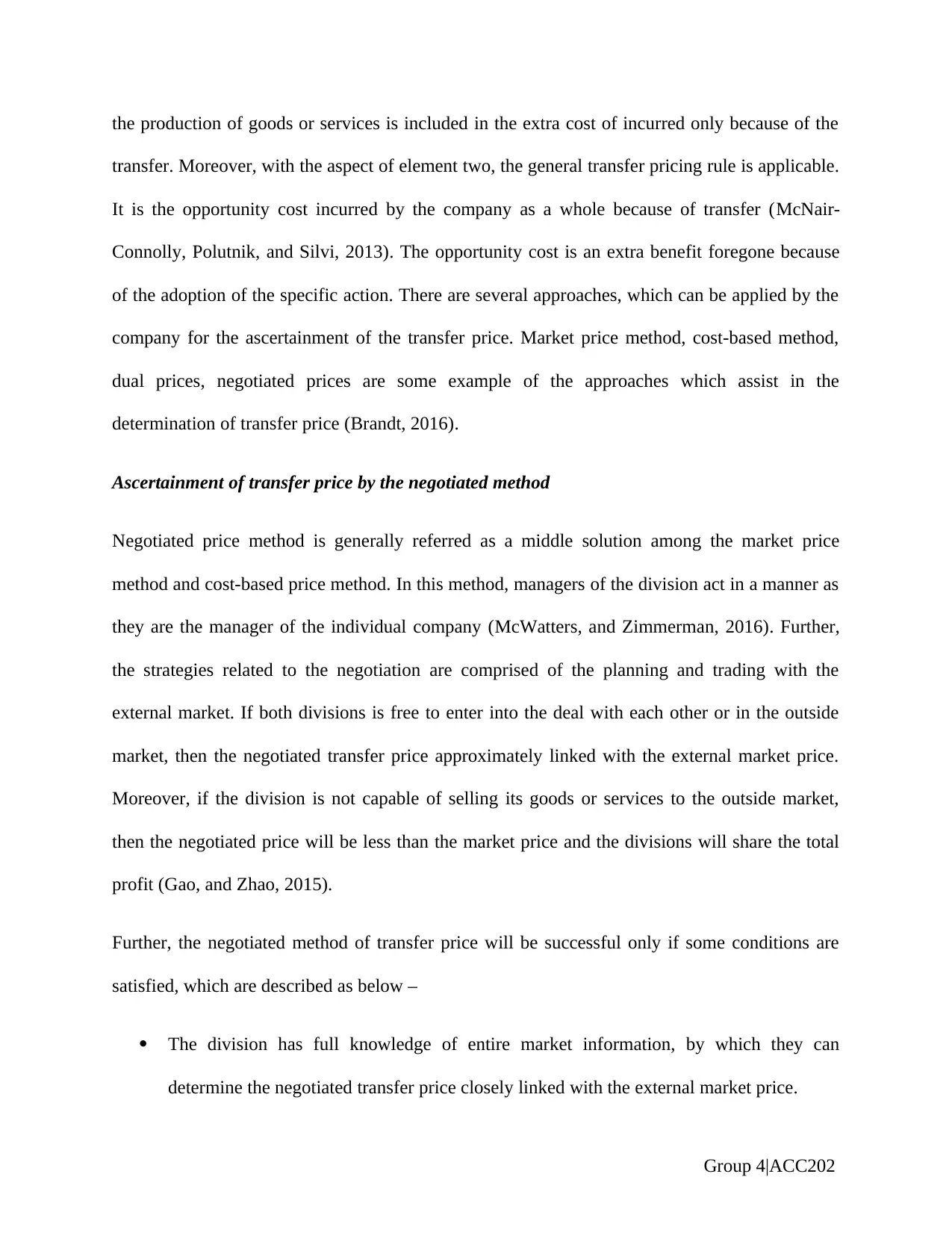
the production of goods or services is included in the extra cost of incurred only because of the
transfer. Moreover, with the aspect of element two, the general transfer pricing rule is applicable.
It is the opportunity cost incurred by the company as a whole because of transfer (McNair-
Connolly, Polutnik, and Silvi, 2013). The opportunity cost is an extra benefit foregone because
of the adoption of the specific action. There are several approaches, which can be applied by the
company for the ascertainment of the transfer price. Market price method, cost-based method,
dual prices, negotiated prices are some example of the approaches which assist in the
determination of transfer price (Brandt, 2016).
Ascertainment of transfer price by the negotiated method
Negotiated price method is generally referred as a middle solution among the market price
method and cost-based price method. In this method, managers of the division act in a manner as
they are the manager of the individual company (McWatters, and Zimmerman, 2016). Further,
the strategies related to the negotiation are comprised of the planning and trading with the
external market. If both divisions is free to enter into the deal with each other or in the outside
market, then the negotiated transfer price approximately linked with the external market price.
Moreover, if the division is not capable of selling its goods or services to the outside market,
then the negotiated price will be less than the market price and the divisions will share the total
profit (Gao, and Zhao, 2015).
Further, the negotiated method of transfer price will be successful only if some conditions are
satisfied, which are described as below –
The division has full knowledge of entire market information, by which they can
determine the negotiated transfer price closely linked with the external market price.
Group 4|ACC202
transfer. Moreover, with the aspect of element two, the general transfer pricing rule is applicable.
It is the opportunity cost incurred by the company as a whole because of transfer (McNair-
Connolly, Polutnik, and Silvi, 2013). The opportunity cost is an extra benefit foregone because
of the adoption of the specific action. There are several approaches, which can be applied by the
company for the ascertainment of the transfer price. Market price method, cost-based method,
dual prices, negotiated prices are some example of the approaches which assist in the
determination of transfer price (Brandt, 2016).
Ascertainment of transfer price by the negotiated method
Negotiated price method is generally referred as a middle solution among the market price
method and cost-based price method. In this method, managers of the division act in a manner as
they are the manager of the individual company (McWatters, and Zimmerman, 2016). Further,
the strategies related to the negotiation are comprised of the planning and trading with the
external market. If both divisions is free to enter into the deal with each other or in the outside
market, then the negotiated transfer price approximately linked with the external market price.
Moreover, if the division is not capable of selling its goods or services to the outside market,
then the negotiated price will be less than the market price and the divisions will share the total
profit (Gao, and Zhao, 2015).
Further, the negotiated method of transfer price will be successful only if some conditions are
satisfied, which are described as below –
The division has full knowledge of entire market information, by which they can
determine the negotiated transfer price closely linked with the external market price.
Group 4|ACC202
Paraphrase This Document
Need a fresh take? Get an instant paraphrase of this document with our AI Paraphraser
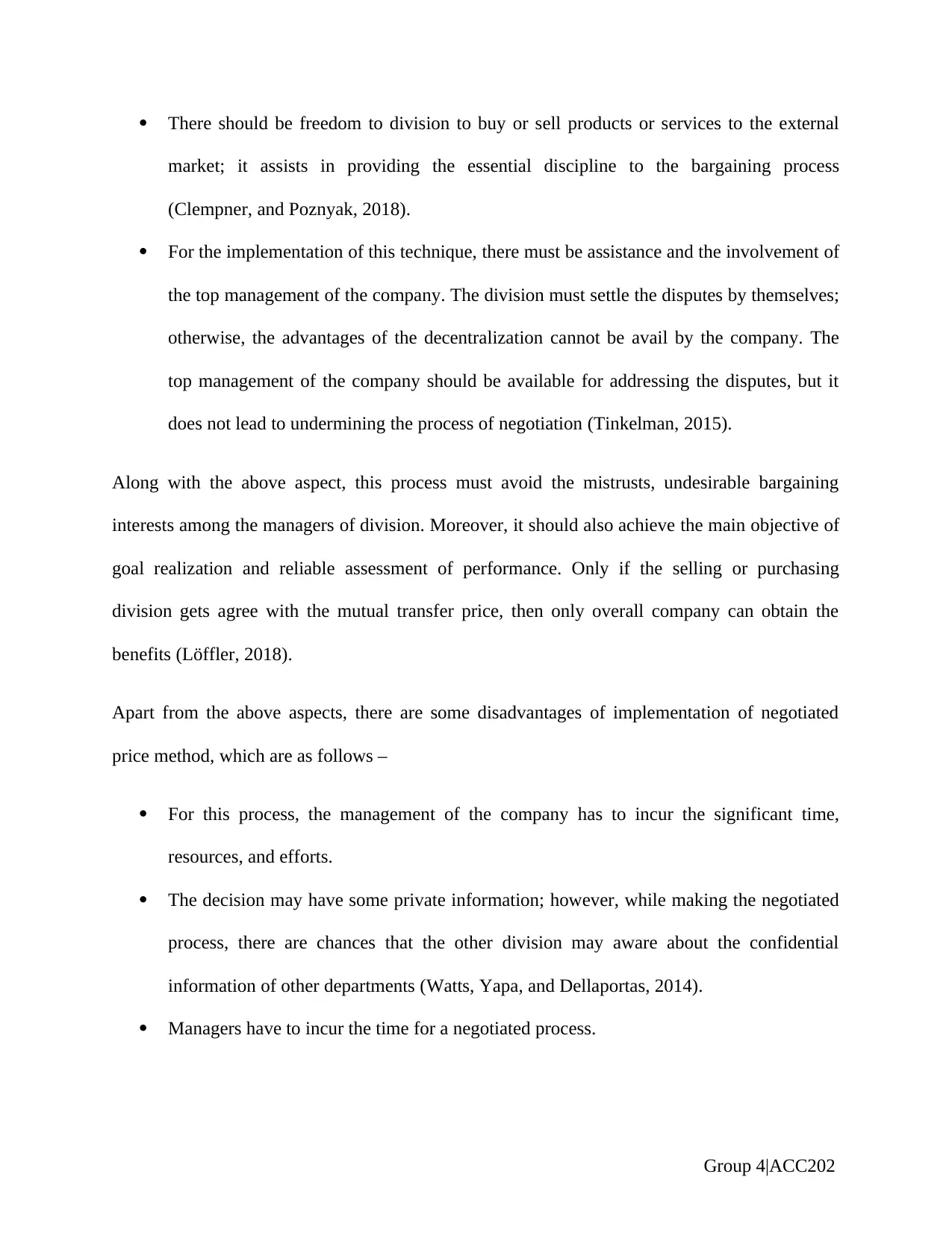
There should be freedom to division to buy or sell products or services to the external
market; it assists in providing the essential discipline to the bargaining process
(Clempner, and Poznyak, 2018).
For the implementation of this technique, there must be assistance and the involvement of
the top management of the company. The division must settle the disputes by themselves;
otherwise, the advantages of the decentralization cannot be avail by the company. The
top management of the company should be available for addressing the disputes, but it
does not lead to undermining the process of negotiation (Tinkelman, 2015).
Along with the above aspect, this process must avoid the mistrusts, undesirable bargaining
interests among the managers of division. Moreover, it should also achieve the main objective of
goal realization and reliable assessment of performance. Only if the selling or purchasing
division gets agree with the mutual transfer price, then only overall company can obtain the
benefits (Löffler, 2018).
Apart from the above aspects, there are some disadvantages of implementation of negotiated
price method, which are as follows –
For this process, the management of the company has to incur the significant time,
resources, and efforts.
The decision may have some private information; however, while making the negotiated
process, there are chances that the other division may aware about the confidential
information of other departments (Watts, Yapa, and Dellaportas, 2014).
Managers have to incur the time for a negotiated process.
Group 4|ACC202
market; it assists in providing the essential discipline to the bargaining process
(Clempner, and Poznyak, 2018).
For the implementation of this technique, there must be assistance and the involvement of
the top management of the company. The division must settle the disputes by themselves;
otherwise, the advantages of the decentralization cannot be avail by the company. The
top management of the company should be available for addressing the disputes, but it
does not lead to undermining the process of negotiation (Tinkelman, 2015).
Along with the above aspect, this process must avoid the mistrusts, undesirable bargaining
interests among the managers of division. Moreover, it should also achieve the main objective of
goal realization and reliable assessment of performance. Only if the selling or purchasing
division gets agree with the mutual transfer price, then only overall company can obtain the
benefits (Löffler, 2018).
Apart from the above aspects, there are some disadvantages of implementation of negotiated
price method, which are as follows –
For this process, the management of the company has to incur the significant time,
resources, and efforts.
The decision may have some private information; however, while making the negotiated
process, there are chances that the other division may aware about the confidential
information of other departments (Watts, Yapa, and Dellaportas, 2014).
Managers have to incur the time for a negotiated process.
Group 4|ACC202
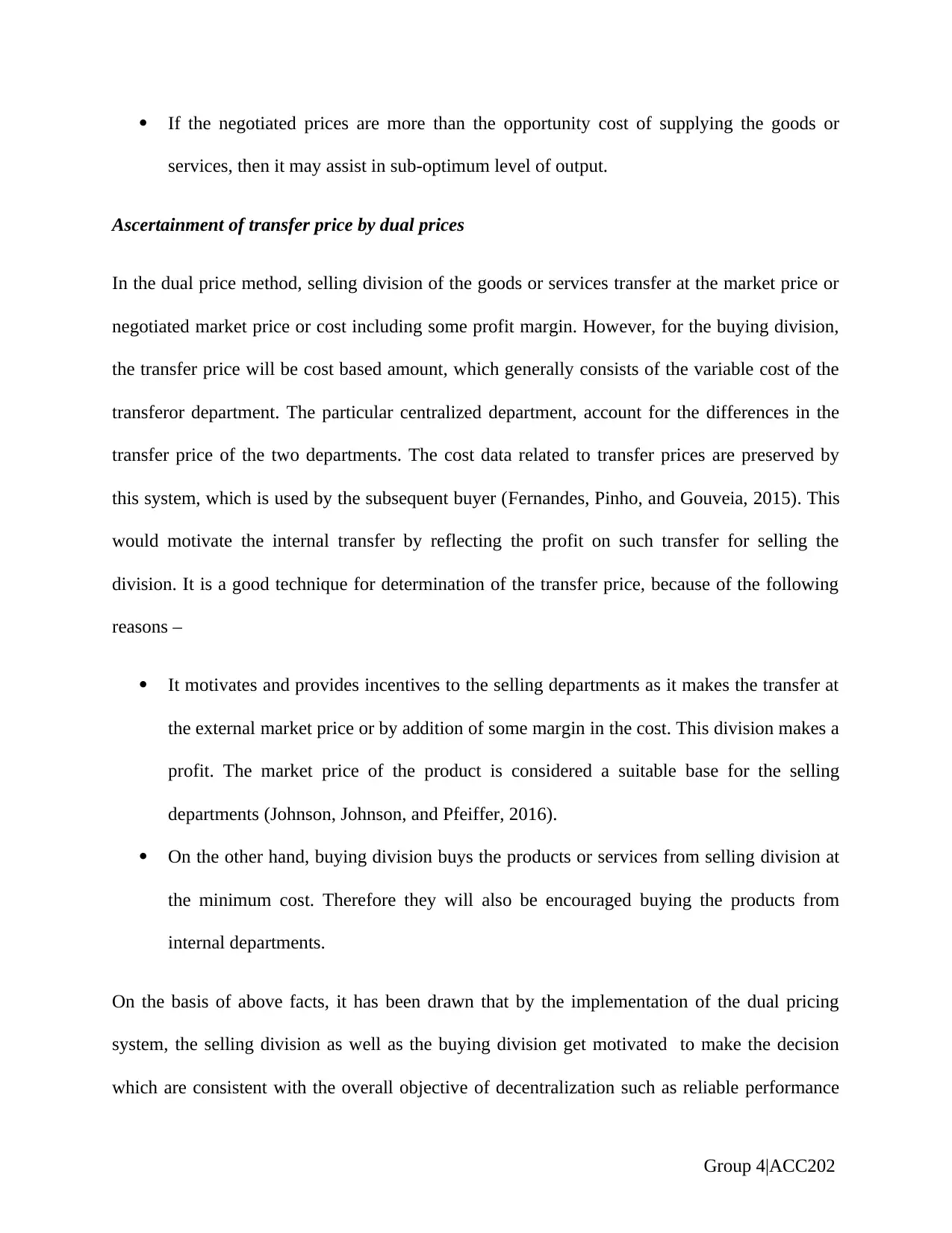
If the negotiated prices are more than the opportunity cost of supplying the goods or
services, then it may assist in sub-optimum level of output.
Ascertainment of transfer price by dual prices
In the dual price method, selling division of the goods or services transfer at the market price or
negotiated market price or cost including some profit margin. However, for the buying division,
the transfer price will be cost based amount, which generally consists of the variable cost of the
transferor department. The particular centralized department, account for the differences in the
transfer price of the two departments. The cost data related to transfer prices are preserved by
this system, which is used by the subsequent buyer (Fernandes, Pinho, and Gouveia, 2015). This
would motivate the internal transfer by reflecting the profit on such transfer for selling the
division. It is a good technique for determination of the transfer price, because of the following
reasons –
It motivates and provides incentives to the selling departments as it makes the transfer at
the external market price or by addition of some margin in the cost. This division makes a
profit. The market price of the product is considered a suitable base for the selling
departments (Johnson, Johnson, and Pfeiffer, 2016).
On the other hand, buying division buys the products or services from selling division at
the minimum cost. Therefore they will also be encouraged buying the products from
internal departments.
On the basis of above facts, it has been drawn that by the implementation of the dual pricing
system, the selling division as well as the buying division get motivated to make the decision
which are consistent with the overall objective of decentralization such as reliable performance
Group 4|ACC202
services, then it may assist in sub-optimum level of output.
Ascertainment of transfer price by dual prices
In the dual price method, selling division of the goods or services transfer at the market price or
negotiated market price or cost including some profit margin. However, for the buying division,
the transfer price will be cost based amount, which generally consists of the variable cost of the
transferor department. The particular centralized department, account for the differences in the
transfer price of the two departments. The cost data related to transfer prices are preserved by
this system, which is used by the subsequent buyer (Fernandes, Pinho, and Gouveia, 2015). This
would motivate the internal transfer by reflecting the profit on such transfer for selling the
division. It is a good technique for determination of the transfer price, because of the following
reasons –
It motivates and provides incentives to the selling departments as it makes the transfer at
the external market price or by addition of some margin in the cost. This division makes a
profit. The market price of the product is considered a suitable base for the selling
departments (Johnson, Johnson, and Pfeiffer, 2016).
On the other hand, buying division buys the products or services from selling division at
the minimum cost. Therefore they will also be encouraged buying the products from
internal departments.
On the basis of above facts, it has been drawn that by the implementation of the dual pricing
system, the selling division as well as the buying division get motivated to make the decision
which are consistent with the overall objective of decentralization such as reliable performance
Group 4|ACC202
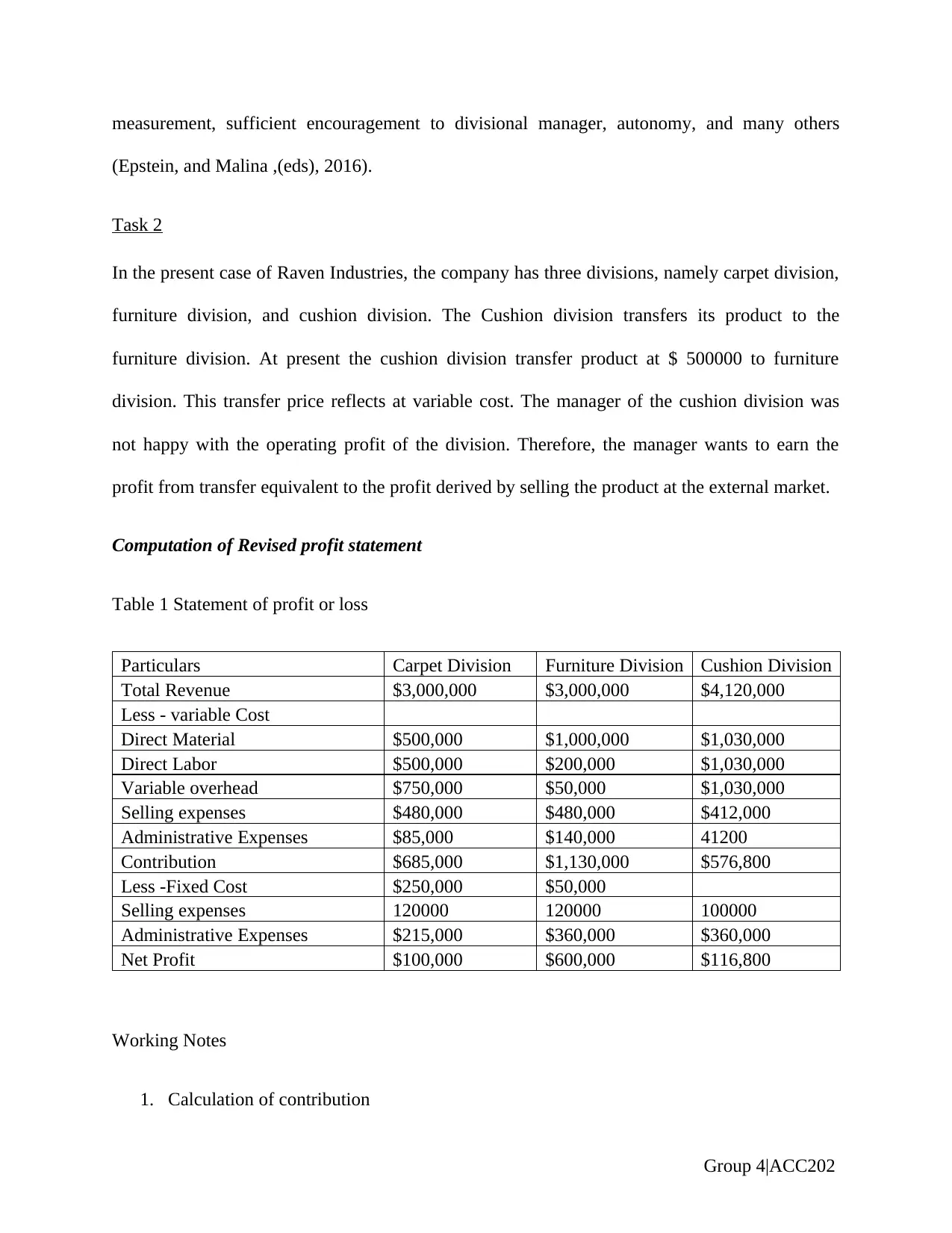
measurement, sufficient encouragement to divisional manager, autonomy, and many others
(Epstein, and Malina ,(eds), 2016).
Task 2
In the present case of Raven Industries, the company has three divisions, namely carpet division,
furniture division, and cushion division. The Cushion division transfers its product to the
furniture division. At present the cushion division transfer product at $ 500000 to furniture
division. This transfer price reflects at variable cost. The manager of the cushion division was
not happy with the operating profit of the division. Therefore, the manager wants to earn the
profit from transfer equivalent to the profit derived by selling the product at the external market.
Computation of Revised profit statement
Table 1 Statement of profit or loss
Particulars Carpet Division Furniture Division Cushion Division
Total Revenue $3,000,000 $3,000,000 $4,120,000
Less - variable Cost
Direct Material $500,000 $1,000,000 $1,030,000
Direct Labor $500,000 $200,000 $1,030,000
Variable overhead $750,000 $50,000 $1,030,000
Selling expenses $480,000 $480,000 $412,000
Administrative Expenses $85,000 $140,000 41200
Contribution $685,000 $1,130,000 $576,800
Less -Fixed Cost $250,000 $50,000
Selling expenses 120000 120000 100000
Administrative Expenses $215,000 $360,000 $360,000
Net Profit $100,000 $600,000 $116,800
Working Notes
1. Calculation of contribution
Group 4|ACC202
(Epstein, and Malina ,(eds), 2016).
Task 2
In the present case of Raven Industries, the company has three divisions, namely carpet division,
furniture division, and cushion division. The Cushion division transfers its product to the
furniture division. At present the cushion division transfer product at $ 500000 to furniture
division. This transfer price reflects at variable cost. The manager of the cushion division was
not happy with the operating profit of the division. Therefore, the manager wants to earn the
profit from transfer equivalent to the profit derived by selling the product at the external market.
Computation of Revised profit statement
Table 1 Statement of profit or loss
Particulars Carpet Division Furniture Division Cushion Division
Total Revenue $3,000,000 $3,000,000 $4,120,000
Less - variable Cost
Direct Material $500,000 $1,000,000 $1,030,000
Direct Labor $500,000 $200,000 $1,030,000
Variable overhead $750,000 $50,000 $1,030,000
Selling expenses $480,000 $480,000 $412,000
Administrative Expenses $85,000 $140,000 41200
Contribution $685,000 $1,130,000 $576,800
Less -Fixed Cost $250,000 $50,000
Selling expenses 120000 120000 100000
Administrative Expenses $215,000 $360,000 $360,000
Net Profit $100,000 $600,000 $116,800
Working Notes
1. Calculation of contribution
Group 4|ACC202
Secure Best Marks with AI Grader
Need help grading? Try our AI Grader for instant feedback on your assignments.
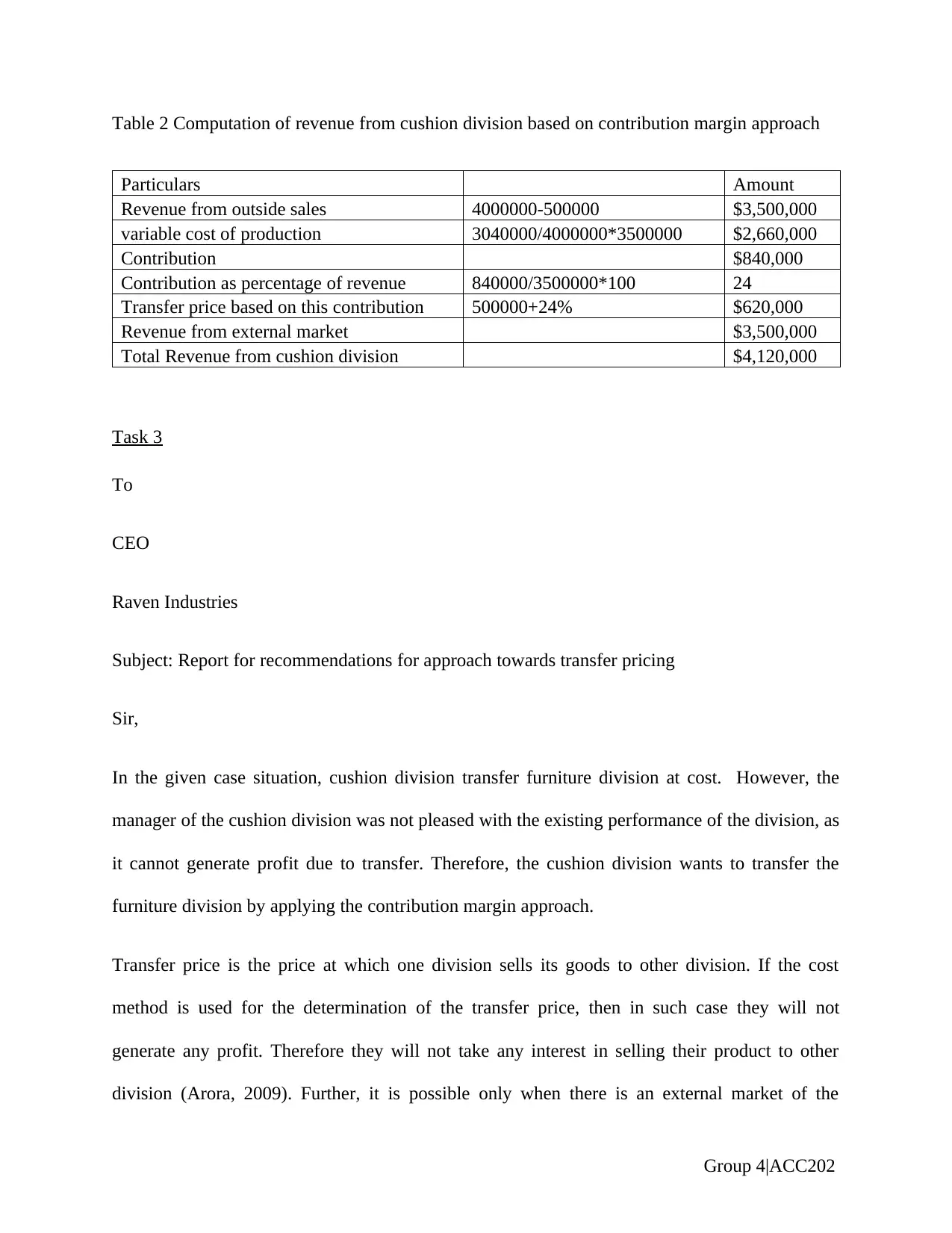
Table 2 Computation of revenue from cushion division based on contribution margin approach
Particulars Amount
Revenue from outside sales 4000000-500000 $3,500,000
variable cost of production 3040000/4000000*3500000 $2,660,000
Contribution $840,000
Contribution as percentage of revenue 840000/3500000*100 24
Transfer price based on this contribution 500000+24% $620,000
Revenue from external market $3,500,000
Total Revenue from cushion division $4,120,000
Task 3
To
CEO
Raven Industries
Subject: Report for recommendations for approach towards transfer pricing
Sir,
In the given case situation, cushion division transfer furniture division at cost. However, the
manager of the cushion division was not pleased with the existing performance of the division, as
it cannot generate profit due to transfer. Therefore, the cushion division wants to transfer the
furniture division by applying the contribution margin approach.
Transfer price is the price at which one division sells its goods to other division. If the cost
method is used for the determination of the transfer price, then in such case they will not
generate any profit. Therefore they will not take any interest in selling their product to other
division (Arora, 2009). Further, it is possible only when there is an external market of the
Group 4|ACC202
Particulars Amount
Revenue from outside sales 4000000-500000 $3,500,000
variable cost of production 3040000/4000000*3500000 $2,660,000
Contribution $840,000
Contribution as percentage of revenue 840000/3500000*100 24
Transfer price based on this contribution 500000+24% $620,000
Revenue from external market $3,500,000
Total Revenue from cushion division $4,120,000
Task 3
To
CEO
Raven Industries
Subject: Report for recommendations for approach towards transfer pricing
Sir,
In the given case situation, cushion division transfer furniture division at cost. However, the
manager of the cushion division was not pleased with the existing performance of the division, as
it cannot generate profit due to transfer. Therefore, the cushion division wants to transfer the
furniture division by applying the contribution margin approach.
Transfer price is the price at which one division sells its goods to other division. If the cost
method is used for the determination of the transfer price, then in such case they will not
generate any profit. Therefore they will not take any interest in selling their product to other
division (Arora, 2009). Further, it is possible only when there is an external market of the
Group 4|ACC202
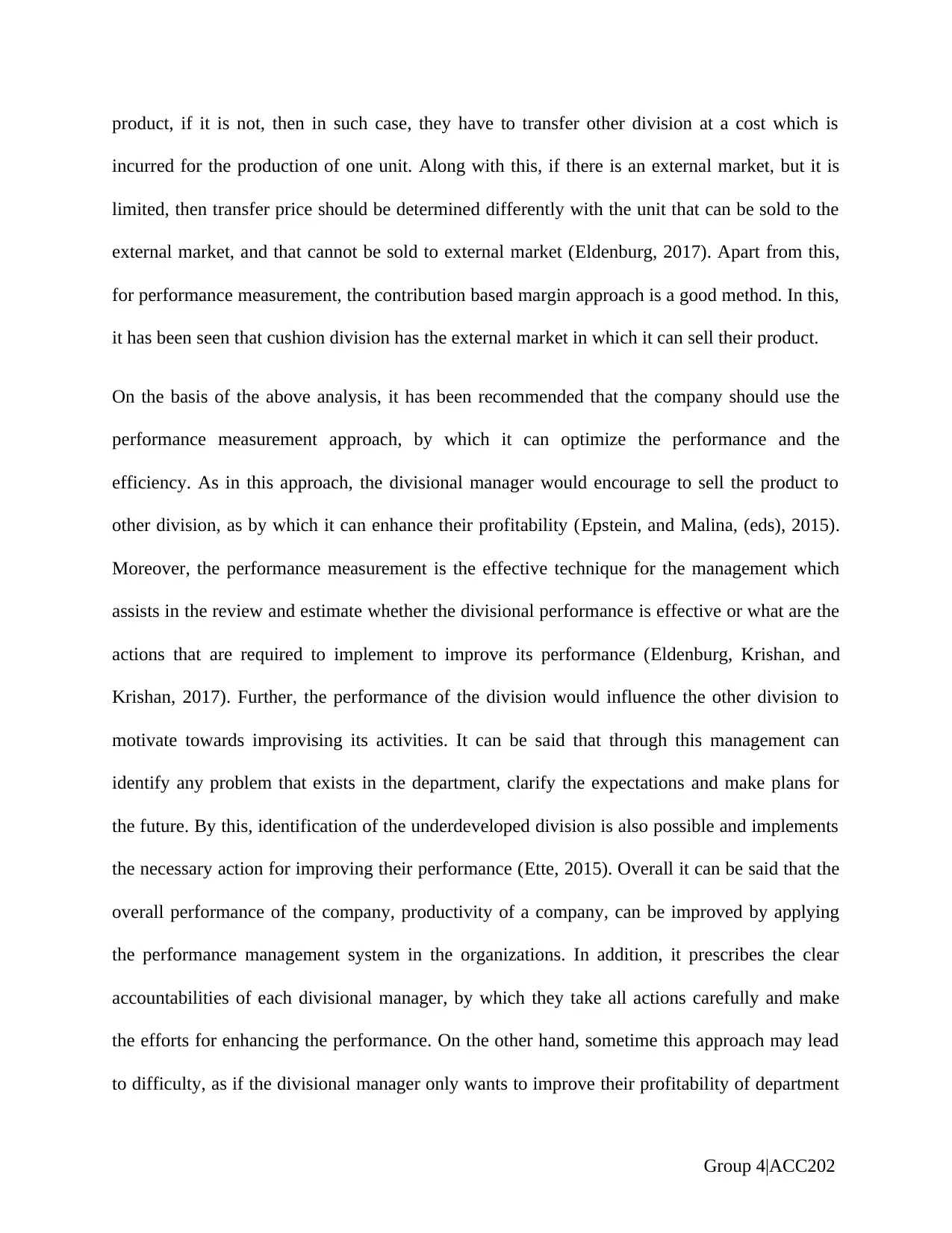
product, if it is not, then in such case, they have to transfer other division at a cost which is
incurred for the production of one unit. Along with this, if there is an external market, but it is
limited, then transfer price should be determined differently with the unit that can be sold to the
external market, and that cannot be sold to external market (Eldenburg, 2017). Apart from this,
for performance measurement, the contribution based margin approach is a good method. In this,
it has been seen that cushion division has the external market in which it can sell their product.
On the basis of the above analysis, it has been recommended that the company should use the
performance measurement approach, by which it can optimize the performance and the
efficiency. As in this approach, the divisional manager would encourage to sell the product to
other division, as by which it can enhance their profitability (Epstein, and Malina, (eds), 2015).
Moreover, the performance measurement is the effective technique for the management which
assists in the review and estimate whether the divisional performance is effective or what are the
actions that are required to implement to improve its performance (Eldenburg, Krishan, and
Krishan, 2017). Further, the performance of the division would influence the other division to
motivate towards improvising its activities. It can be said that through this management can
identify any problem that exists in the department, clarify the expectations and make plans for
the future. By this, identification of the underdeveloped division is also possible and implements
the necessary action for improving their performance (Ette, 2015). Overall it can be said that the
overall performance of the company, productivity of a company, can be improved by applying
the performance management system in the organizations. In addition, it prescribes the clear
accountabilities of each divisional manager, by which they take all actions carefully and make
the efforts for enhancing the performance. On the other hand, sometime this approach may lead
to difficulty, as if the divisional manager only wants to improve their profitability of department
Group 4|ACC202
incurred for the production of one unit. Along with this, if there is an external market, but it is
limited, then transfer price should be determined differently with the unit that can be sold to the
external market, and that cannot be sold to external market (Eldenburg, 2017). Apart from this,
for performance measurement, the contribution based margin approach is a good method. In this,
it has been seen that cushion division has the external market in which it can sell their product.
On the basis of the above analysis, it has been recommended that the company should use the
performance measurement approach, by which it can optimize the performance and the
efficiency. As in this approach, the divisional manager would encourage to sell the product to
other division, as by which it can enhance their profitability (Epstein, and Malina, (eds), 2015).
Moreover, the performance measurement is the effective technique for the management which
assists in the review and estimate whether the divisional performance is effective or what are the
actions that are required to implement to improve its performance (Eldenburg, Krishan, and
Krishan, 2017). Further, the performance of the division would influence the other division to
motivate towards improvising its activities. It can be said that through this management can
identify any problem that exists in the department, clarify the expectations and make plans for
the future. By this, identification of the underdeveloped division is also possible and implements
the necessary action for improving their performance (Ette, 2015). Overall it can be said that the
overall performance of the company, productivity of a company, can be improved by applying
the performance management system in the organizations. In addition, it prescribes the clear
accountabilities of each divisional manager, by which they take all actions carefully and make
the efforts for enhancing the performance. On the other hand, sometime this approach may lead
to difficulty, as if the divisional manager only wants to improve their profitability of department
Group 4|ACC202
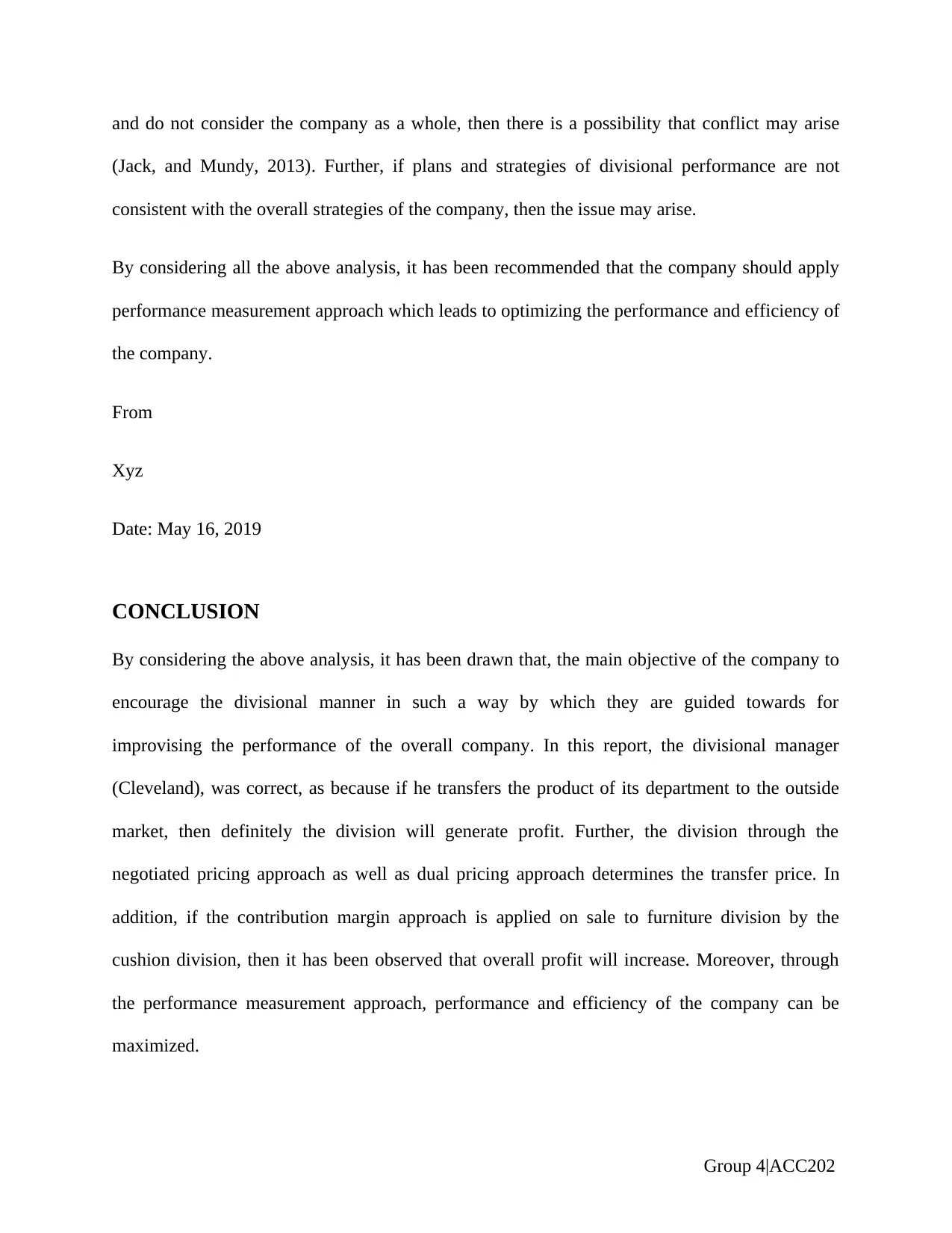
and do not consider the company as a whole, then there is a possibility that conflict may arise
(Jack, and Mundy, 2013). Further, if plans and strategies of divisional performance are not
consistent with the overall strategies of the company, then the issue may arise.
By considering all the above analysis, it has been recommended that the company should apply
performance measurement approach which leads to optimizing the performance and efficiency of
the company.
From
Xyz
Date: May 16, 2019
CONCLUSION
By considering the above analysis, it has been drawn that, the main objective of the company to
encourage the divisional manner in such a way by which they are guided towards for
improvising the performance of the overall company. In this report, the divisional manager
(Cleveland), was correct, as because if he transfers the product of its department to the outside
market, then definitely the division will generate profit. Further, the division through the
negotiated pricing approach as well as dual pricing approach determines the transfer price. In
addition, if the contribution margin approach is applied on sale to furniture division by the
cushion division, then it has been observed that overall profit will increase. Moreover, through
the performance measurement approach, performance and efficiency of the company can be
maximized.
Group 4|ACC202
(Jack, and Mundy, 2013). Further, if plans and strategies of divisional performance are not
consistent with the overall strategies of the company, then the issue may arise.
By considering all the above analysis, it has been recommended that the company should apply
performance measurement approach which leads to optimizing the performance and efficiency of
the company.
From
Xyz
Date: May 16, 2019
CONCLUSION
By considering the above analysis, it has been drawn that, the main objective of the company to
encourage the divisional manner in such a way by which they are guided towards for
improvising the performance of the overall company. In this report, the divisional manager
(Cleveland), was correct, as because if he transfers the product of its department to the outside
market, then definitely the division will generate profit. Further, the division through the
negotiated pricing approach as well as dual pricing approach determines the transfer price. In
addition, if the contribution margin approach is applied on sale to furniture division by the
cushion division, then it has been observed that overall profit will increase. Moreover, through
the performance measurement approach, performance and efficiency of the company can be
maximized.
Group 4|ACC202
Paraphrase This Document
Need a fresh take? Get an instant paraphrase of this document with our AI Paraphraser
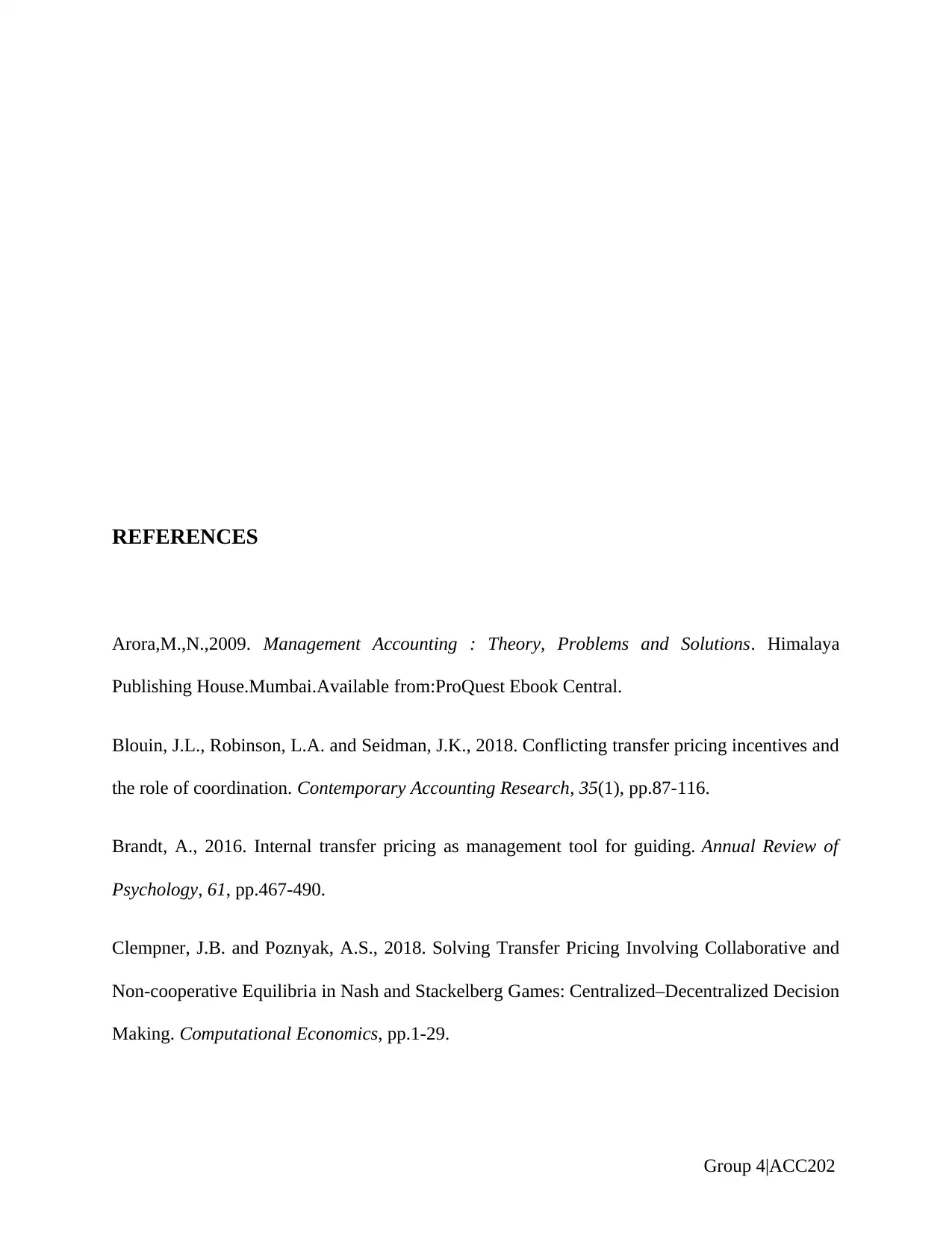
REFERENCES
Arora,M.,N.,2009. Management Accounting : Theory, Problems and Solutions. Himalaya
Publishing House.Mumbai.Available from:ProQuest Ebook Central.
Blouin, J.L., Robinson, L.A. and Seidman, J.K., 2018. Conflicting transfer pricing incentives and
the role of coordination. Contemporary Accounting Research, 35(1), pp.87-116.
Brandt, A., 2016. Internal transfer pricing as management tool for guiding. Annual Review of
Psychology, 61, pp.467-490.
Clempner, J.B. and Poznyak, A.S., 2018. Solving Transfer Pricing Involving Collaborative and
Non-cooperative Equilibria in Nash and Stackelberg Games: Centralized–Decentralized Decision
Making. Computational Economics, pp.1-29.
Group 4|ACC202
Arora,M.,N.,2009. Management Accounting : Theory, Problems and Solutions. Himalaya
Publishing House.Mumbai.Available from:ProQuest Ebook Central.
Blouin, J.L., Robinson, L.A. and Seidman, J.K., 2018. Conflicting transfer pricing incentives and
the role of coordination. Contemporary Accounting Research, 35(1), pp.87-116.
Brandt, A., 2016. Internal transfer pricing as management tool for guiding. Annual Review of
Psychology, 61, pp.467-490.
Clempner, J.B. and Poznyak, A.S., 2018. Solving Transfer Pricing Involving Collaborative and
Non-cooperative Equilibria in Nash and Stackelberg Games: Centralized–Decentralized Decision
Making. Computational Economics, pp.1-29.
Group 4|ACC202
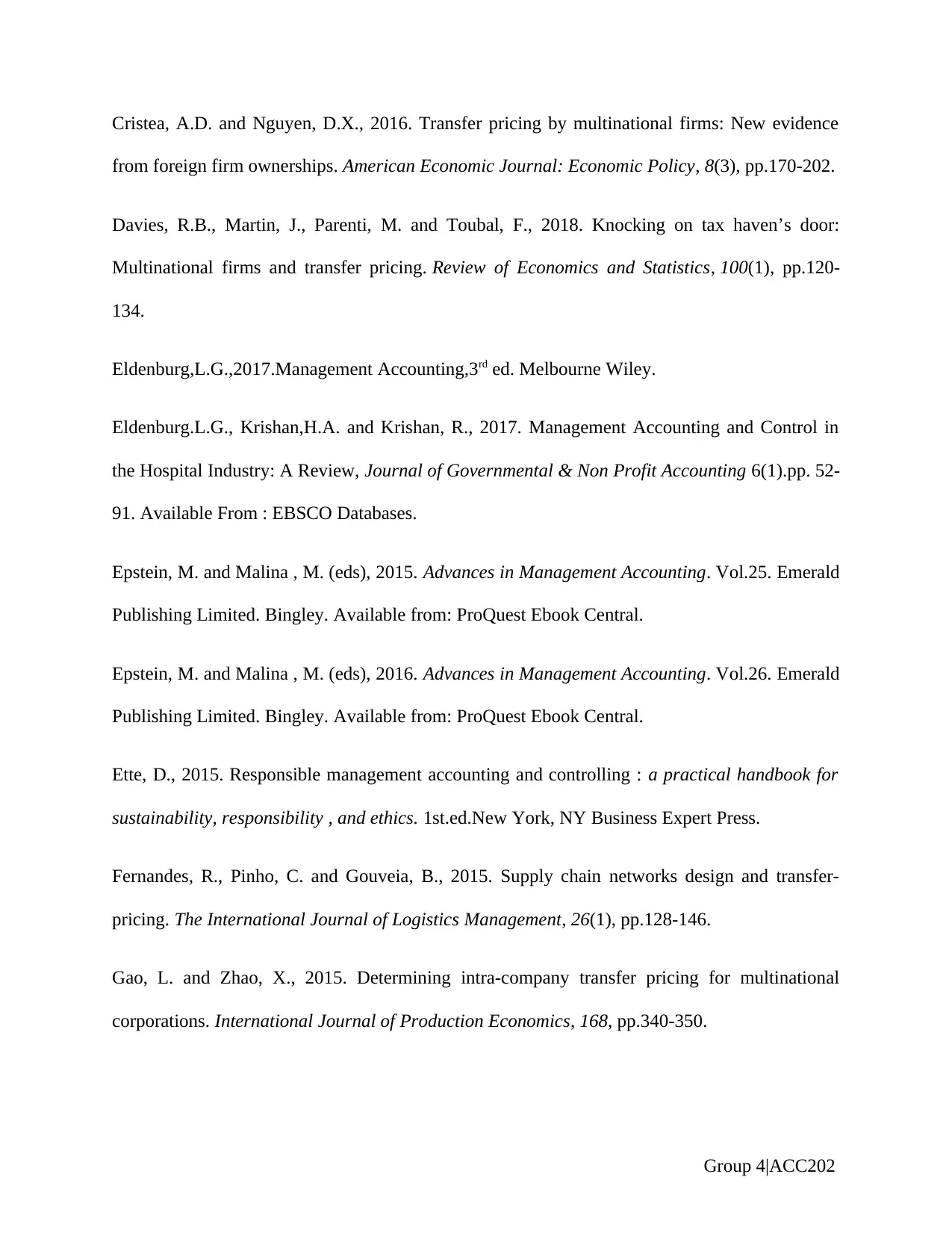
Cristea, A.D. and Nguyen, D.X., 2016. Transfer pricing by multinational firms: New evidence
from foreign firm ownerships. American Economic Journal: Economic Policy, 8(3), pp.170-202.
Davies, R.B., Martin, J., Parenti, M. and Toubal, F., 2018. Knocking on tax haven’s door:
Multinational firms and transfer pricing. Review of Economics and Statistics, 100(1), pp.120-
134.
Eldenburg,L.G.,2017.Management Accounting,3rd ed. Melbourne Wiley.
Eldenburg.L.G., Krishan,H.A. and Krishan, R., 2017. Management Accounting and Control in
the Hospital Industry: A Review, Journal of Governmental & Non Profit Accounting 6(1).pp. 52-
91. Available From : EBSCO Databases.
Epstein, M. and Malina , M. (eds), 2015. Advances in Management Accounting. Vol.25. Emerald
Publishing Limited. Bingley. Available from: ProQuest Ebook Central.
Epstein, M. and Malina , M. (eds), 2016. Advances in Management Accounting. Vol.26. Emerald
Publishing Limited. Bingley. Available from: ProQuest Ebook Central.
Ette, D., 2015. Responsible management accounting and controlling : a practical handbook for
sustainability, responsibility , and ethics. 1st.ed.New York, NY Business Expert Press.
Fernandes, R., Pinho, C. and Gouveia, B., 2015. Supply chain networks design and transfer-
pricing. The International Journal of Logistics Management, 26(1), pp.128-146.
Gao, L. and Zhao, X., 2015. Determining intra-company transfer pricing for multinational
corporations. International Journal of Production Economics, 168, pp.340-350.
Group 4|ACC202
from foreign firm ownerships. American Economic Journal: Economic Policy, 8(3), pp.170-202.
Davies, R.B., Martin, J., Parenti, M. and Toubal, F., 2018. Knocking on tax haven’s door:
Multinational firms and transfer pricing. Review of Economics and Statistics, 100(1), pp.120-
134.
Eldenburg,L.G.,2017.Management Accounting,3rd ed. Melbourne Wiley.
Eldenburg.L.G., Krishan,H.A. and Krishan, R., 2017. Management Accounting and Control in
the Hospital Industry: A Review, Journal of Governmental & Non Profit Accounting 6(1).pp. 52-
91. Available From : EBSCO Databases.
Epstein, M. and Malina , M. (eds), 2015. Advances in Management Accounting. Vol.25. Emerald
Publishing Limited. Bingley. Available from: ProQuest Ebook Central.
Epstein, M. and Malina , M. (eds), 2016. Advances in Management Accounting. Vol.26. Emerald
Publishing Limited. Bingley. Available from: ProQuest Ebook Central.
Ette, D., 2015. Responsible management accounting and controlling : a practical handbook for
sustainability, responsibility , and ethics. 1st.ed.New York, NY Business Expert Press.
Fernandes, R., Pinho, C. and Gouveia, B., 2015. Supply chain networks design and transfer-
pricing. The International Journal of Logistics Management, 26(1), pp.128-146.
Gao, L. and Zhao, X., 2015. Determining intra-company transfer pricing for multinational
corporations. International Journal of Production Economics, 168, pp.340-350.
Group 4|ACC202
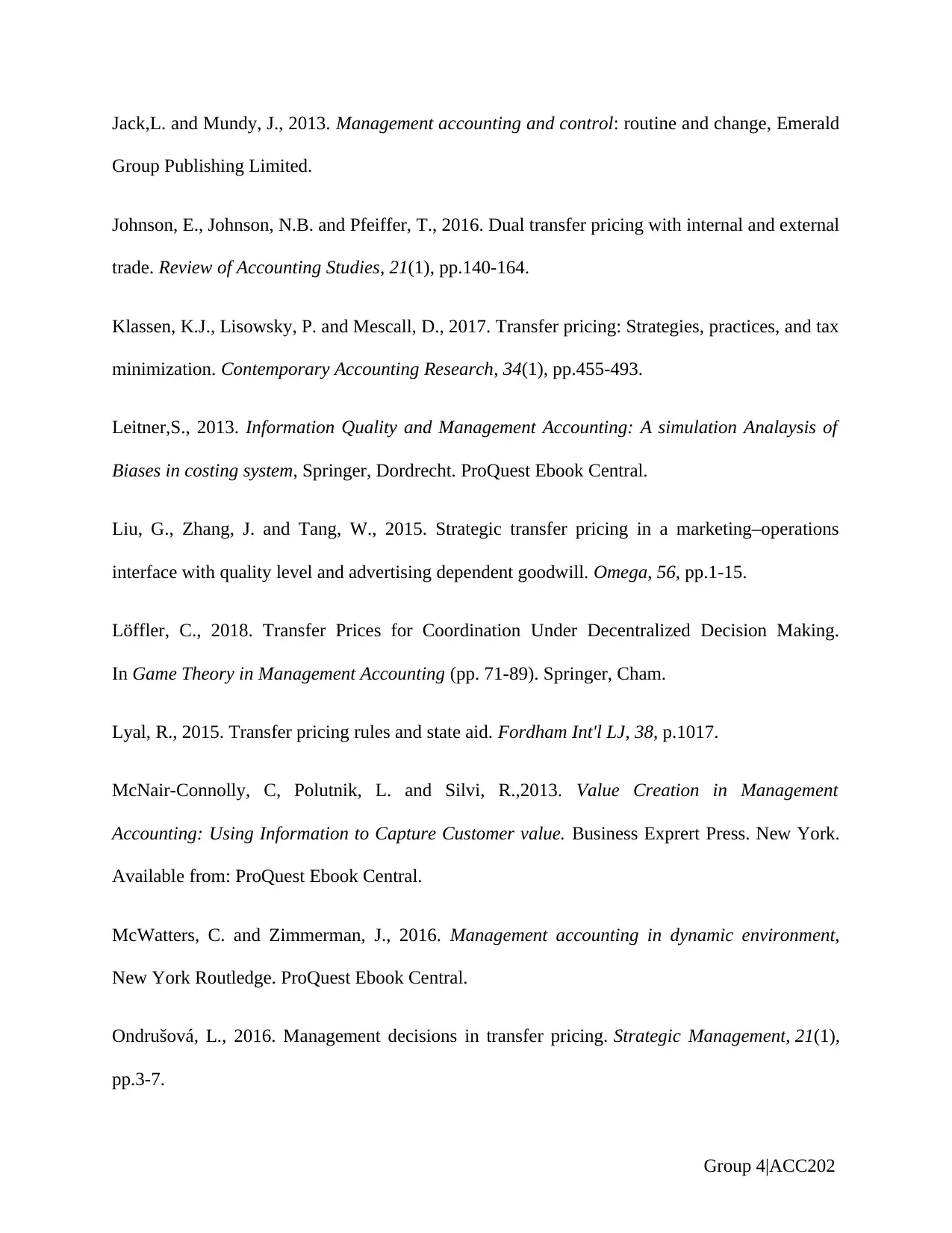
Jack,L. and Mundy, J., 2013. Management accounting and control: routine and change, Emerald
Group Publishing Limited.
Johnson, E., Johnson, N.B. and Pfeiffer, T., 2016. Dual transfer pricing with internal and external
trade. Review of Accounting Studies, 21(1), pp.140-164.
Klassen, K.J., Lisowsky, P. and Mescall, D., 2017. Transfer pricing: Strategies, practices, and tax
minimization. Contemporary Accounting Research, 34(1), pp.455-493.
Leitner,S., 2013. Information Quality and Management Accounting: A simulation Analaysis of
Biases in costing system, Springer, Dordrecht. ProQuest Ebook Central.
Liu, G., Zhang, J. and Tang, W., 2015. Strategic transfer pricing in a marketing–operations
interface with quality level and advertising dependent goodwill. Omega, 56, pp.1-15.
Löffler, C., 2018. Transfer Prices for Coordination Under Decentralized Decision Making.
In Game Theory in Management Accounting (pp. 71-89). Springer, Cham.
Lyal, R., 2015. Transfer pricing rules and state aid. Fordham Int'l LJ, 38, p.1017.
McNair-Connolly, C, Polutnik, L. and Silvi, R.,2013. Value Creation in Management
Accounting: Using Information to Capture Customer value. Business Exprert Press. New York.
Available from: ProQuest Ebook Central.
McWatters, C. and Zimmerman, J., 2016. Management accounting in dynamic environment,
New York Routledge. ProQuest Ebook Central.
Ondrušová, L., 2016. Management decisions in transfer pricing. Strategic Management, 21(1),
pp.3-7.
Group 4|ACC202
Group Publishing Limited.
Johnson, E., Johnson, N.B. and Pfeiffer, T., 2016. Dual transfer pricing with internal and external
trade. Review of Accounting Studies, 21(1), pp.140-164.
Klassen, K.J., Lisowsky, P. and Mescall, D., 2017. Transfer pricing: Strategies, practices, and tax
minimization. Contemporary Accounting Research, 34(1), pp.455-493.
Leitner,S., 2013. Information Quality and Management Accounting: A simulation Analaysis of
Biases in costing system, Springer, Dordrecht. ProQuest Ebook Central.
Liu, G., Zhang, J. and Tang, W., 2015. Strategic transfer pricing in a marketing–operations
interface with quality level and advertising dependent goodwill. Omega, 56, pp.1-15.
Löffler, C., 2018. Transfer Prices for Coordination Under Decentralized Decision Making.
In Game Theory in Management Accounting (pp. 71-89). Springer, Cham.
Lyal, R., 2015. Transfer pricing rules and state aid. Fordham Int'l LJ, 38, p.1017.
McNair-Connolly, C, Polutnik, L. and Silvi, R.,2013. Value Creation in Management
Accounting: Using Information to Capture Customer value. Business Exprert Press. New York.
Available from: ProQuest Ebook Central.
McWatters, C. and Zimmerman, J., 2016. Management accounting in dynamic environment,
New York Routledge. ProQuest Ebook Central.
Ondrušová, L., 2016. Management decisions in transfer pricing. Strategic Management, 21(1),
pp.3-7.
Group 4|ACC202
Secure Best Marks with AI Grader
Need help grading? Try our AI Grader for instant feedback on your assignments.
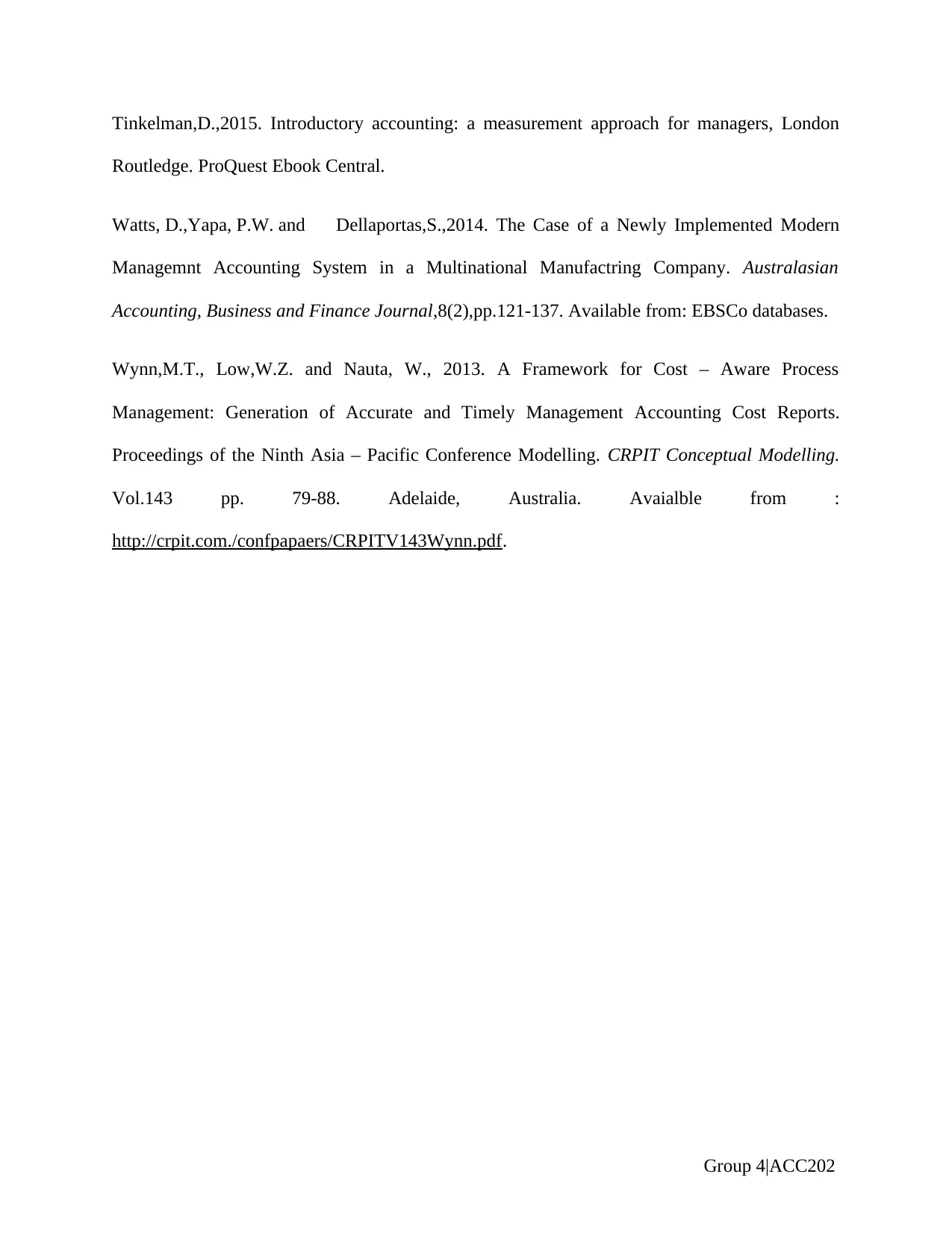
Tinkelman,D.,2015. Introductory accounting: a measurement approach for managers, London
Routledge. ProQuest Ebook Central.
Watts, D.,Yapa, P.W. and Dellaportas,S.,2014. The Case of a Newly Implemented Modern
Managemnt Accounting System in a Multinational Manufactring Company. Australasian
Accounting, Business and Finance Journal,8(2),pp.121-137. Available from: EBSCo databases.
Wynn,M.T., Low,W.Z. and Nauta, W., 2013. A Framework for Cost – Aware Process
Management: Generation of Accurate and Timely Management Accounting Cost Reports.
Proceedings of the Ninth Asia – Pacific Conference Modelling. CRPIT Conceptual Modelling.
Vol.143 pp. 79-88. Adelaide, Australia. Avaialble from :
http://crpit.com./confpapaers/CRPITV143Wynn.pdf.
Group 4|ACC202
Routledge. ProQuest Ebook Central.
Watts, D.,Yapa, P.W. and Dellaportas,S.,2014. The Case of a Newly Implemented Modern
Managemnt Accounting System in a Multinational Manufactring Company. Australasian
Accounting, Business and Finance Journal,8(2),pp.121-137. Available from: EBSCo databases.
Wynn,M.T., Low,W.Z. and Nauta, W., 2013. A Framework for Cost – Aware Process
Management: Generation of Accurate and Timely Management Accounting Cost Reports.
Proceedings of the Ninth Asia – Pacific Conference Modelling. CRPIT Conceptual Modelling.
Vol.143 pp. 79-88. Adelaide, Australia. Avaialble from :
http://crpit.com./confpapaers/CRPITV143Wynn.pdf.
Group 4|ACC202
1 out of 17
Related Documents
Your All-in-One AI-Powered Toolkit for Academic Success.
+13062052269
info@desklib.com
Available 24*7 on WhatsApp / Email
![[object Object]](/_next/static/media/star-bottom.7253800d.svg)
Unlock your academic potential
© 2024 | Zucol Services PVT LTD | All rights reserved.



